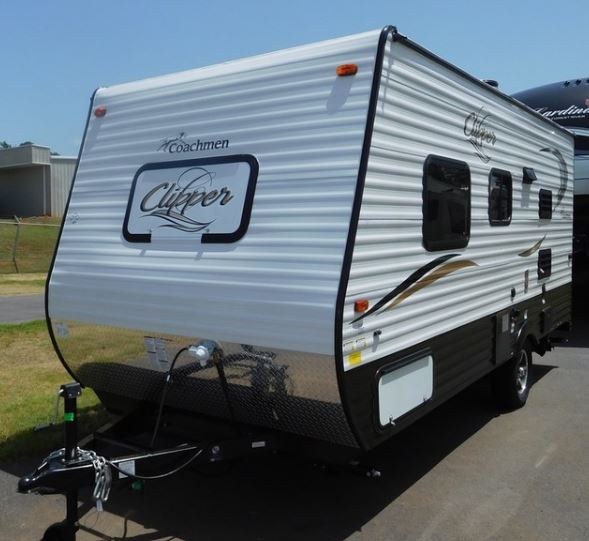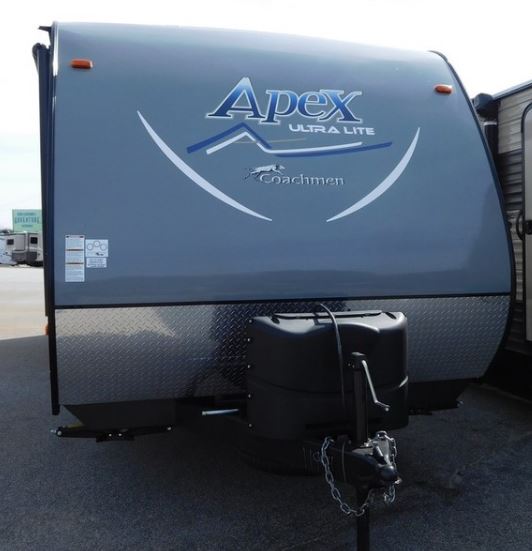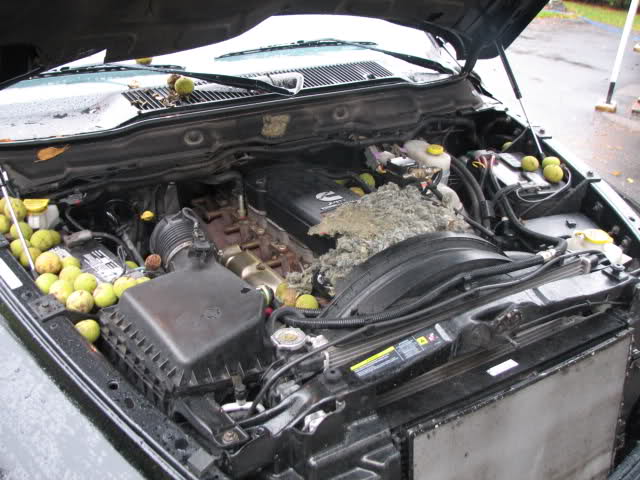Have a safe and fun Halloween Weekend!
rvs
2017 Coachmen Clipper Ultra-Lite 17FB

The longstanding tradition of Coachmen Value in recreational vehicles continues with the all new Clipper travel trailer.
Designed with today’s smaller, fuel efficient tow vehicles in mind, the Clipper travel trailers weigh around 2500 lbs. Fully equipped with all the creature comforts of larger more expensive models, the Clipper travel trailer provides the ultimate value in lightweight towables.
Coachmen Clipper… a product by campers for campers! From the most trusted name in camping.
2017 Coachmen Apex Limited Edition 28LE

An Apex Travel Trailer does not just start off as a frame, walls and roofs… it begins with an idea! Our belief is that getting the little things right is a BIG THING! The Apex is not like other lightweight trailers… it is much smarter because we set new, higher standards for this innovative, truly lightweight trailer.
What makes an Apex smarter? Quality – Lightweight – Innovation – Eco-friendly – Design.
Each and every Apex model must achieve high scores in each of these standards in order to earn the Apex seal of approval. Our rating system is gathered and driven by the end user… you the customer… in order to produce a quality and most customer friendly lightweight trailer on the market!
8 Tips For A Happier Camping Pet

Your pet is going to have their own idea of how much they like or dislike your imposing a move or trip on them. What we can offer here are ways to help them acclimate to their new situation.
1. Keep Things Familiar
Your pet usually has a schedule at home. A food schedule, walking schedule, a time that you come home, entertainment time and so on. When you go on a trip, try to keep some of that schedule the same. Bring the things they use from home such as their bedding, food and water bowls and any toys that they like to play with. Make an effort to feed them around the same time you usually do at home. This isn’t rocket science, but it might not cross your mind until it’s too late. Your pet(s) will appreciate your keeping some things familiar to them. Your payback just might be that they don’t bark or meow incessantly. They will also settle in faster.
2. Exercise Your Dogs As Much As Possible
Dogs need stimulation. The best stimulation you can give them is a structured walk. No, we don’t mean taking them out to a dog park and letting them run around with crazy energy. This is akin to letting kids out to play at recess. When they come back in, they are even MORE wound up than they were before recess. Dogs need a mental challenge and a structured, calm, LONG walk is the #1 best way to achieve this. It will get you off of the couch at the same time. What are you doing on the couch on a camping trip, anyway?
3. Don’t Put Them In Your Trailer While Driving
We understand that not many dog or cat owners out there use a harness/seat belt for their pets when in transit. This was going to be our #1 recommendation, until we saw a video about how many of them fail. We still believe the car will be safer and more comfortable than in your trailer. Why not in the trailer? First, you aren’t there with them so their fear factor is likely to rise. To them, they are riding alone in what to them could be a building having an ongoing earthquake. They don’t know what’s going on really, so why throw them back there to be alone and scared?
4. Watch Where You Leave Them
As you hopefully are already aware, most RVs can quickly get hot in the sun, much like a car can. If you are camping in an RV park, and you have your A/C on, be aware that the power can shut off without notice, leaving your pet(s) in a very deadly situation if your windows are all closed and it’s a hot sunny day. What can you do to prevent disaster for your pets? First, never leave your windows closed and fans not running if the temperatures are going to be even as high as the low 70’s. You should have a good idea of how quickly and how much hotter than the outside temperature your rig gets before you ever leave your pets in your rig at temperatures over 70.
5. Get Them Ready
If you never take your cat or dog in the car for trips, it’s a very good idea to acclimate them to the motion and feeling by taking short trips before your big one. Start with a simple around the block drive. Don’t get all excited before asking them to get in the car, stay calm and assertive. Praise them if they are behaving properly but don’t get too overzealous about it. Once they realize the car isn’t going to kill them, start extending the duration of your trips. Treats may help them learn to associate the vehicle with positive things, but only give the treats when they are being calm, not if they are shaking or are barking/hiding.
6. Bring Their Medications And Vaccination Records
This may seem like another no-brainer, but people do forget these things. If your dog or cat needs a daily medication at home, he’s going to need it on the road as well! Don’t forget these items. It’s just a good idea to have their vet records as well. Don’t want to haul the paper? Scan it into an app on your phone.
7. Get Them Microchipped
If you haven’t done this already, now is the time. If your pet gets out and runs away, their collar with name and phone number is their best friend. However, if they lose their collar somehow or you had it off, say to give them a bath, then the chances of you ever getting them back is extremely low. Microchipping will be the only hope if someone finds your pet and takes them to a vet to see if they are microchipped.
8. Be A Good Neighbor
Let’s be honest. If you have a dog that you KNOW barks incessantly when you leave, you shouldn’t be bringing them with you to an RV park if you plan to leave them in your rig. It’s just totally inconsiderate.
How to Park an RV

You’ve finally made it to the campground. But before you can run off to the lake or go for a hike, the first order of the day is to park and level your RV so that your refrigerator will operate properly and you don’t find yourself in bed at night with your feet higher than your head.
Never assume your site will be flat or level. That would make parking an RV too easy. Due to the nature of camping, chances are higher that your site will be rutted, gouged and somewhat uneven.
But don’t fret. You can still get your RV into your spot, and leveled so it operates properly, with a few easy steps. Here’s how:
How to Park an RV
With many campsites designed to accommodate smaller vehicles, easing your 30-foot long fifth-wheeler or even longer motorhome into some spots can be a challenge.
How to Level an RV
There are several reasons to make sure your RV is level, including proper refrigerator operation and safe slide out extension (if you have them). You’ll also want to stabilize your rig so that it doesn’t sway when you move about inside or in windy conditions.
Many luxury motorhomes and trailers come equipped with exotic self-leveling systems, with hydraulic or electric rams that extend at the touch of a button and level the coach automatically. For rigs without this nicety, leveling blocks or ramps and a small bubble level are required.
Leveling blocks or ramps don’t have to be expensive. They can be as simple as a stack of 2×10-inch boards. Or, you can step up to interlocking RV leveling blocks. Made of high-strength plastic, these blocks are touted as being able to bear the weight of even the largest motorhomes and trailers.
1) With your RV positioned in the site where you want it, place the bubble level on the floor to determine if the unit is level both front-to back and side-to-side. If you have slide outs, extend them now to see which way your trailer or motorhome leans. Then retract them for safety.
2) Next, mark some lines in the dirt in front or back of the tires on the side that needs to be leveled.
3) Now pull your rig forward (or back it up) so that the tires are clear of the lines. Place your boards or blocks in position. If you determine that you’ll need several layers of boards or blocks to get your rig level, build them in a ramp configuration.
Don’t try to force your RV to climb up more than 2 inches at a time.
4) Move your motorhome or trailer up onto the levelers, making sure to keep the tire footprint completely on the boards or blocks. Don’t let your tires overhang any edge as this can cause damage.
5) Now check the bubble level again and adjust the height of the boards or blocks as needed so that your rig is level side-to-side. When all looks good, place wheel chocks in front or behind the tires (depending which way the site slopes) to keep the trailer from moving. You can then disconnect your trailer from your tow vehicle and use the trailer’s hitch jack (or a fifth-wheel’s “landing gear”) to fine-tune the front-to-rear level.
For motorhomes, put the transmission in “park” and set the parking brake.
How to Stabilize Your RV
Now that your RV is level, you’ll want to stabilize it so it doesn’t rock back and forth when you walk around inside. You should use stabilizing jacks to accomplish this.
Note: These should never be used to level a rig, as they weren’t designed for that purpose.
Stabilizing jacks come in several configurations. The most common is the scissor jack, which is usually bolted or welded to the trailer’s frame at the front and rear.
Pop-up tent trailers are frequently equipped with a drop-down style jack, which, as the name implies, drops down from the frame.
To use the stabilizing jacks after you’ve leveled the RV:
1. Lower the jacks following the manufacturer’s instructions. To save time and give the foot of each jack a larger base, slide a couple of short 2×4- or 2×6-inch boards beneath each foot. This is especially helpful if the ground is loose or sandy.
2. Once the jack foot is in contact with the ground, give the crank a few extra turns to provide the trailer a secure footing. Check the bubble level to make sure your RV remains level. Do this for all four corners.
And that’s how to park and level an RV! Your RV is now safely in the campsite and ready to enjoy. When you get ready to leave just reverse these steps, remembering to raise the jacks to their travel position, and collect and store your leveling boards or blocks.
10 Alternatives to the Classic Hot Dog
When someone says “barbecue” you think of the classic meal: A hotdog, a bun, a zig of mustard and a zag of ketchup. Maybe a few onions and relish on top, depending on your preferences.
While the classic hot dog is a campsite staple, it’s not your only option. A few unconventional toppings are all you need to create a whole new meal, or you can choose a different kind of dog altogether. Chew on these ideas before you shop for your next camping trip.
Chili Dog
Pair a traditional hot dog with vegetarian or beef chili for a delicious twist on the classic preparation. What’s better, you can make the chili at the campsite in your Dutch oven and eat the leftovers for another meal.
Chicken Sausage
Throw out the hot dog altogether and nosh on chicken sausage instead. Applegate Farms makes a variety of gourmet flavors like organic chicken and apple sausage, organic andouille sausage and organic fire roasted red pepper sausage.
Chicken Dog
Chicken hot dogs are leaner than all-beef or beef and poultry mix dogs, making them lower in fat and often sodium, as well. Pair your chicken dog with a whole-wheat bun for a healthy hot dog dinner.
Turkey Sausage
If you want to ditch the hot dog altogether, swap it out for a turkey sausage. Cook it over the fire for the smoky, charred flavor that makes campfire cooking so delicious and unique.
Corndog
This childhood favorite is a great hot dog alternative, but don’t buy the frozen version. Instead, make your own right at the campsite.
Vegan Dog
Many shy away from vegan and vegetarian dogs because of their unappetizing and processed ingredients. However, if you choose not to eat meat, but still want to have a dog around the campfire. While some of their ingredients are less than ideal, they pride themselves on using mostly all-natural ingredients like apple cider vinegar and paprika.
Uncured All Beef
An uncured, all-beef hot dog varies in taste and health benefits. An uncured dog has no nitrates, which come from the salts used in a traditional curing process.
Seafood Roll
If you don’t want a hot dog or sausage at all, choose a different protein. With fresh fish and veggies you can still fill a hot dog bun, without having to skip out all together.
Pizza Dog
Ditch the ketchup, mustard and onions for marinara, cheese and pepperoni when you opt for a pizza dog. Make sure to roast your dog on a stick so you still get the campfire flavor that’s so delicious.
Bacon Dog
While this isn’t the healthiest alternative, it’s certainly different from the traditional option. Remember, this hot dog variation will need to be cooked in a pan over the fire so the bacon stays wrapped.
RECOGNIZING THE SIGNS OF VEHICLE ENGINE DAMAGE

It’s not always easy to recognize when your vehicle is suffering from engine damage as symptoms can be overlooked and seen as “normal.” While not all sounds and smells may threaten the life of your engine, there are some obvious warning signs that require a vehicle inspection right away.
Early diagnosis of engine damage can most likely be treated, but it is important to be aware of potentially damaging symptoms and have the vehicle inspected if something doesn’t seem right. By acting quickly and making necessary repairs as soon as possible, you could be saving yourself from the cost and hassle of breaking down along the road.
One of the signs of engine trouble is an illuminated check engine light. This light indicates that a vehicle system, such as the ignition, fuel injection or emission control, is not operating properly, even if the vehicle appears to be running normally. Ignoring the check engine light can negatively impact your fuel economy or cause damage resulting in more costly repairs.
Many motorists are familiar with the noises their vehicles make on a daily basis. However, any noise that is new, different or suspicious may indicate a problem, including a high-pitched squeal, grinding or thumping. Sounds under the hood, such as hissing, can also indicate that your vehicle is in need of attention.
Although all vehicles burn fossil fuels that create undesired emissions, these odors should remain outside of it. Unusual smells that could signal engine damage include: burnt rubber, hot oil, gasoline, sweet smell of syrup, burning carpet and rotten eggs. When you smell any peculiar odor, you should not ignore it.
Another symptom of engine damage is excessive amounts of smoke or steam. Although some smoke is normal, excessive amounts of dark smoke in particular indicates that oil is leaking into the combustion chamber and is being burned along with the gasoline.
Ways to Prevent Identity Theft While Traveling

Tips for avoiding scams and theft while traveling are a staple of the travel writing genre; pretty much every guidebook or travel website dedicates some space to the subject.
But in the 21st century, you are as much at risk of having your identity stolen — or more accurately your financial and digital identity — as you are of getting “mugged,” which almost sounds quaint these days (though I do not intend in any way to underplay the misery and danger of actually getting mugged).
Identity theft is a growing problem worldwide — especially for travelers, who are very vulnerable, forced as they are to use unsecured Internet connections, carry extensive personal documentation with them at all times, and share their credit cards with merchants about whom they know nothing and whom they’ll never see again.
Modern technology hasn’t made it any easier for honest folks to avoid identity theft, either; witness the practice of websites like Facebook and LinkedIn, which often keep you logged in to the site, even after you close your browser or turn off your computer. Someone getting unfettered access to your closest friends on Facebook could definitely shake out some very “helpful” information before you knew it.
As time and technology advance, this problem is only going to affect more travelers.
Here are tips to avoid identity theft while traveling:
“Unpack” Critical Documents Before Travel
If you carry some essential documents with you when you are not traveling — the average wallet or purse might include a Social Security card, bank statements, medical documents, checkbook and the like — remove them before you leave home. Essentially, when it comes to documentation, you want to “unpack” before traveling.
Be Very Careful About Shared and Insecure Internet Connections
This is one thing that I have found very difficult to do – when traveling, it is hard to find connections other than public ones at hotels, cafes, airports, you name it. To see the warning “this connection is unsecured and others may see your information” is almost a staple of the travel experience. The risk applies to anything you type into your keyboard while connected, such as email passwords and website logins.
Use Only Bank ATM’s
A recent trend among identity thieves has been to install card readers in an ATM by which they can access your card number and PIN. This happens most often at non-bank, “generic” ATM’s (in hotels, convenience stores, etc.), which have less oversight and are therefore more vulnerable than bank-run and hosted ATM’s. Stick with the ones at banks; these can still be compromised, but tend to be targeted by thieves much less often.
Change Passwords and PIN’s
You may want to change your passwords after a trip; identity thieves are thought to be very patient criminals, and often wait until you are less likely to pay attention after a few weeks at home.



